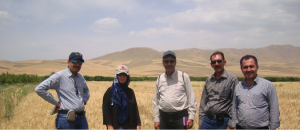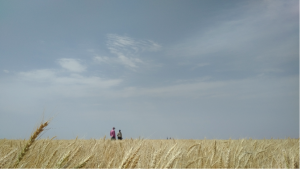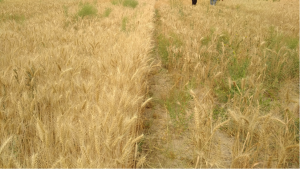El Batan, Mexico
July 31, 2017

Picture shows (L-R): Mahesh Kumar Gathala (CIMMYT), Marta Lopes (CIMMYT-Turkey), Jalal Kamali (CIMMYT-Iran), Mozaffar Roustaii (DARI) and Loghman Alipashaei a farmer in Iran. CIMMYT/Handout
Harsh weather conditions exacerbated by climate change make winter wheat production difficult in northwestern Iran and the Anatolia region of Turkey, but due to some recent discoveries, scientists are optimistic that they can help smallholder farmers combat hardship and sustain their livelihoods.
After conducting field trials in a year when rainfall was scarce, temperatures dropped to minus 20 degrees Celsius, and irrigation reserves were depleted leaving only about 350 millimeters of water available for crops, scientists identified key genetic resources.
“Our work demonstrates that research trials can have an immediate impact in farmers fields,” said Marta Lopes, a wheat physiologist at the International Maize and Wheat Improvement Center (CIMMYT), describing the impact of collaborative trials undertaken with scientists at the Iranian national agricultural research program.
“These fluctuating environments restrict our ability to define the parameters of drought and heat tolerance in this region of the world, requiring optimization of traits and identification of wheat types that best adapt to these regions,” Lopes said.

Mozaffar Roustaii and Jalal Kamali scoring yield trials in Maragheh, Iran (DARI). CIMMYT/Marta Lopes
Over the past five years, physiologists at CIMMYT in Turkey have been working with Iranian scientists at the Dryland Agricultural Research Institute (DARI) to learn more about traits and genes required help wheat cope with harsh environments. One of the varieties included in the research showed so much promise it was immediately selected for on-farm trials, but further work is needed, she said.
Their work exploring how winter wheat adapts to disparate climate patterns in the region is currently being conducted through a collaborative Iran-Turkey project funded by the European Union.
Winter wheat grows on more than 5 million hectares in Anatolia and northwestern Iran in the province of Maragheh and is subjected to ever-changing rainfall patterns, extreme cold temperatures in winter and hot temperatures in spring and summer. Drought and variable temperatures can occur at different stages of wheat development depending on the year.

GRISET 16=885K4.1//MNG/SDV1/3/1D13.1/MLT CIT925099-0SE-0YC-3YC-0YC-4YC-0YC-1YM-0YM is shown on the left growing on a farm in Oshnavieh, Iran with supplementary irrigation — winter temperatures fell below -20 and total available water was around 350 mm with supplementary irrigation. This wheat variety was released by the International winter wheat improvement program in 1992. CIMMYT/Marta Lopes
Because winter wheat is planted in the autumn, it has to withstand a period of cold before it develops grain, but if temperatures are too severe, it will not survive.
The contrasts between Anatolia and Maragheh are noteworthy. In Anatolia a certain amount of rainfall is expected during and after the winter crop enters the reproductive phase, which is also known as the grain filling period. In Maragheh, rainfall is unlikely during the grain filling period and the temperature rapidly increases.
Mozaffar Roustaii, a wheat breeder at DARI, and Jalal Kamali, senior wheat breeder and CIMMYT liaison in Iran, selected the wheat genetic resources for the collaborative project. The resources have been included in the national winter wheat breeding program for cross breeding.
“Research takes time, repetition and perseverance, and the impact on farmers’ fields is eventually attained several years later, building on the knowledge being generated by many great scientists worldwide,” Lopes said.
“In the era of ‘big data’ and advances in modeling, physiology, breeding, agronomy and industry, it’s even more important that we work together and understand each other to cope with food insecurity in a changing climate,” she added.
The research is funded by the CGIAR Research Program on Wheat and the European Union project, “Addressing the challenges of climate change for sustainable food security in Turkey, Iran and Morocco to promote the use of wheat genetic resources and increase genetic gains.”